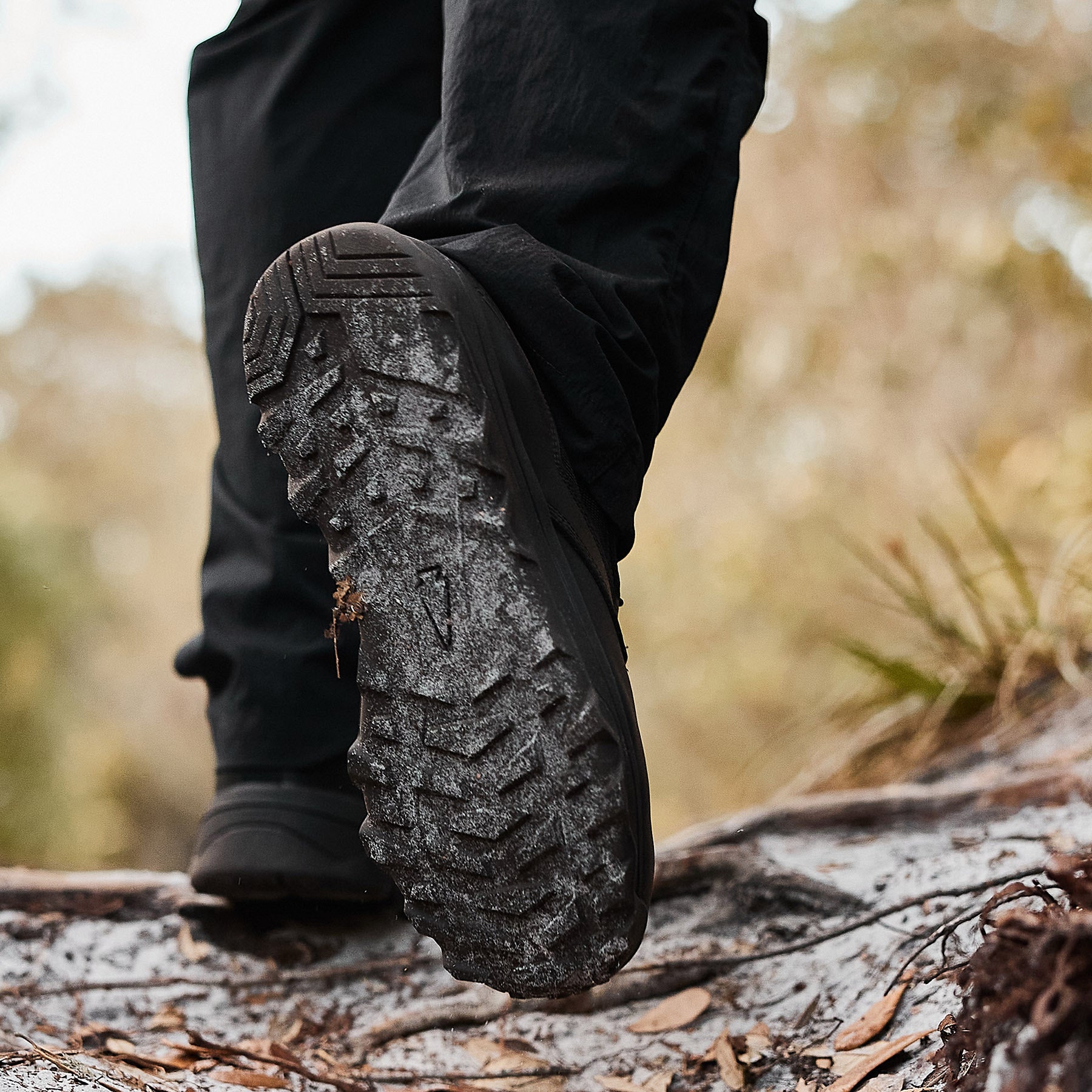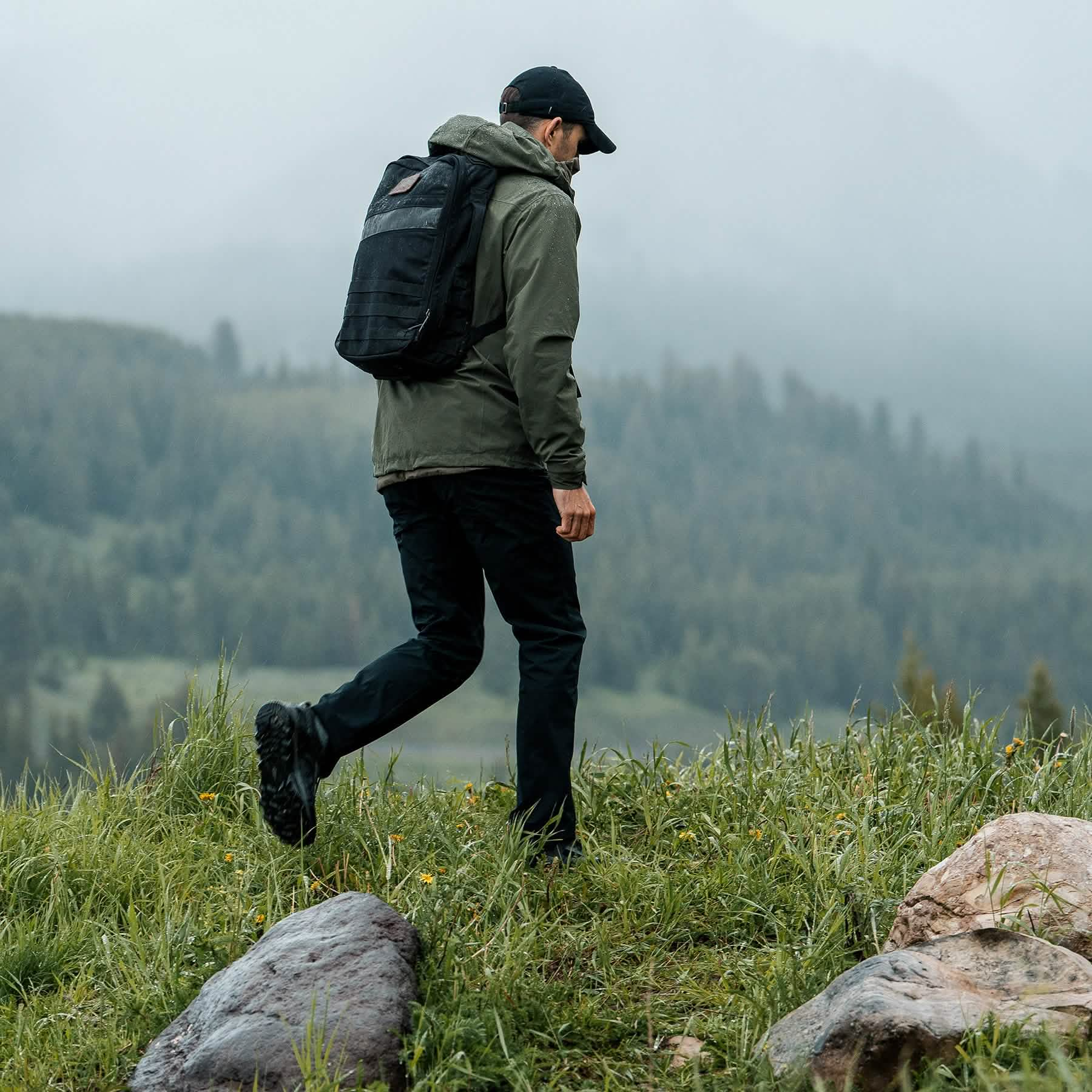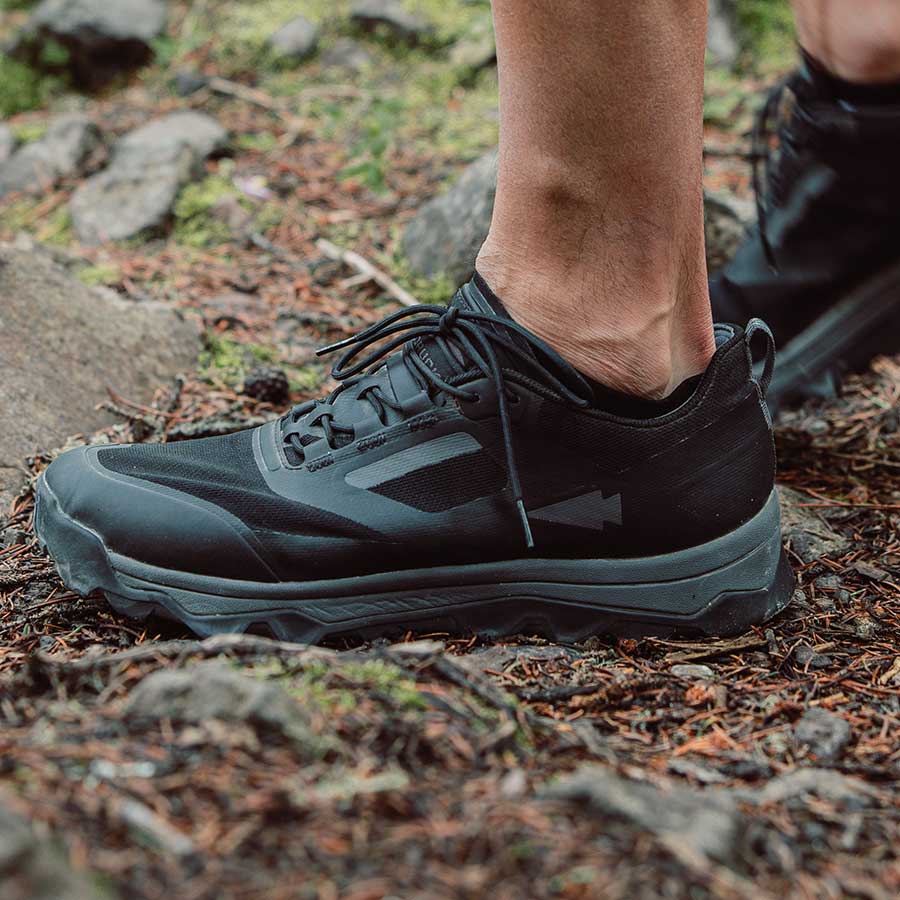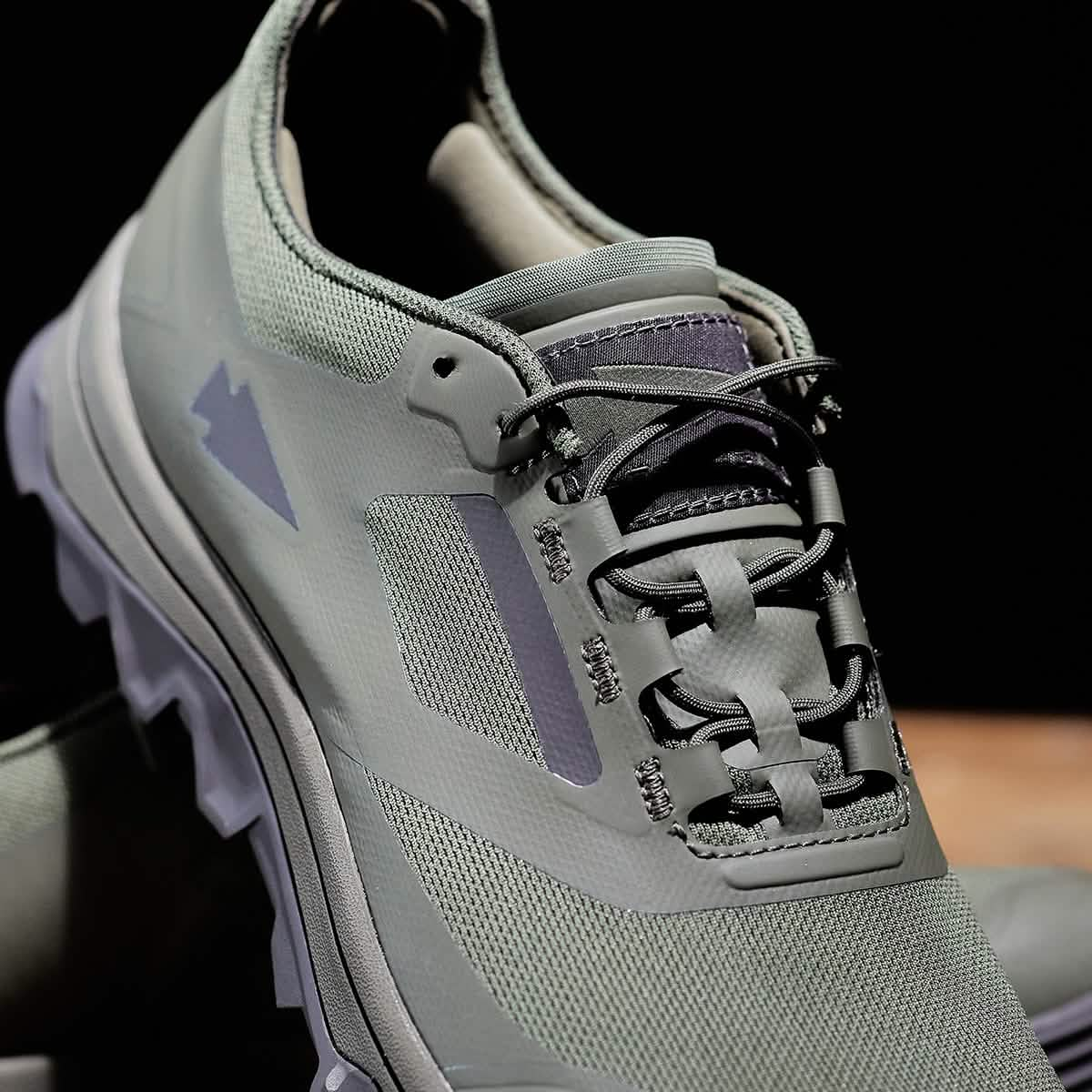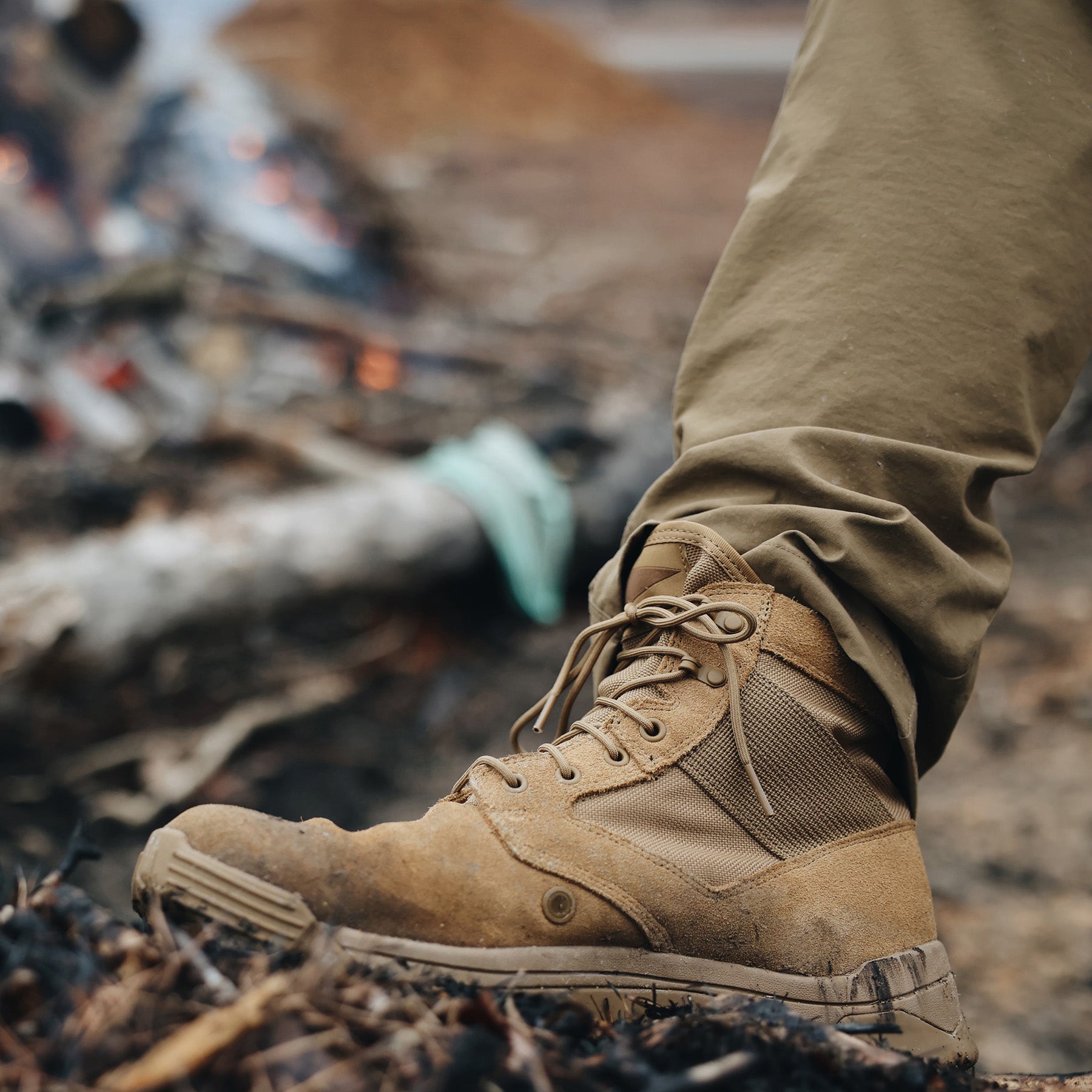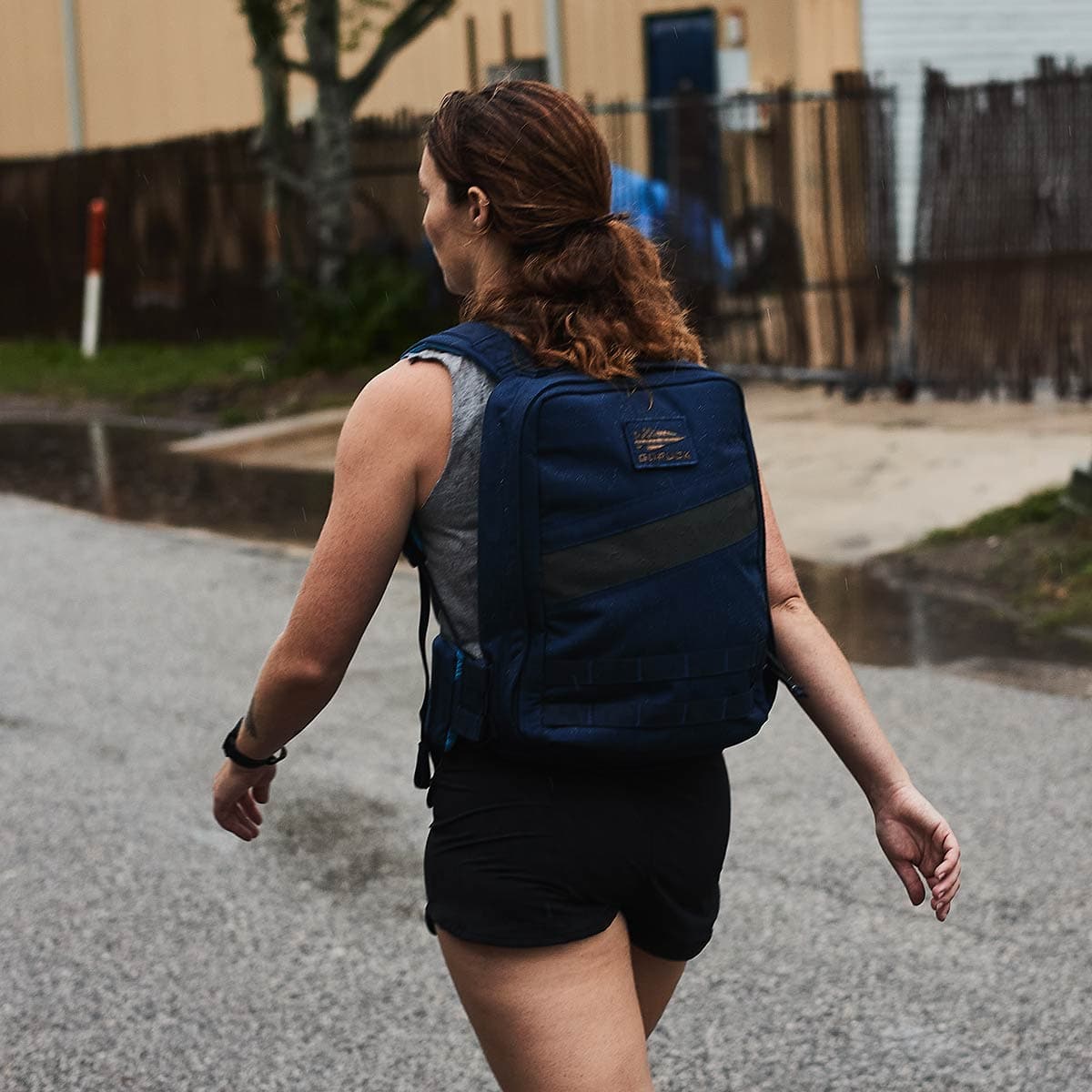Hiking shoes vs boots: the two preferred footwear options for hiking enthusiasts. You'll see both on local trails and big mountains across the world. In years past, hiking boots were the preferred footwear option for trail adventures. Now, though, both shoes and boots are popular options. Many hikers, in fact, have both hiking shoes and boots in their closets.
So which is best for you?
Well, in the hiking shoes vs boots debate, there isn't always a perfect answer. Oftentimes it comes down to personal preference. However, certain conditions and activities may be more comfortable and safe in boots. Low top hiking shoes have their place, too.
So the short answer is this: it depends. It depends on you, where you're headed, and how rugged the conditions will be.
Let's break down hiking shoes vs hiking boots.
Hiking footwear can be confusing. There're shoes and boots, waterproof options, and even trail running shoes. It's important to choose the right shoes for hiking, because when your feet are happy, you can hike longer and farther. The more time you spend on your feet, the more amazing places you get to see and experience.
Table of Contents: Jump Ahead
What All Trail Shoes Need
Not all shoes and boots are good for hiking. While some hiking trails are gravel, most are dirt, sand, and rocks. They could be full of roots, too. Leaves and mud can make dirt surfaces slippery and some trails cross creeks. In short, hiking takes you on uneven surfaces. Those uneven surfaces go up and down steep hills. Good trail shoes ensure your feet, knees, hips, and back are well taken care of.
No matter if you hike an hour every weekend with your friends or have a bucket list of mountains you want to climb, proper hiking footwear is essential to have a good time (check out more hiking essentials here). It's a safety and comfort thing. Once you've worn good hiking shoes or boots, it's hard to go back to your cross trainers or strap sandals.
Here's what all trail shoes should have, whether they're low top shoes or hiking boots...
1. Rugged, rubber outsole
The bottom of your shoe should have rubber claws that grip the soft ground. Those rubber claws, or tread, help you walk uphill by grabbing the earth and pulling. When you hike downhill, the tread under your heel will stop you from slipping and sliding down.
That's the most important feature of a hiking shoe or boot. Once you've experienced proper hiking shoes with thick, rugged tread, you'll never go back to regular shoes.
That rugged outsole on your hiking shoes or boots also helps you scamper over slick logs and boulders, if needed.
2. Firm, protective foam
Some hiking shoes have an internal rock plate, a plastic board that protects your feet from roots and rocks poking through. It's not really necessary, unless the shoe uses marshmallow soft foam. We don't like marshmallow-soft foam for hiking, so find some shoes or boots that are comfortable, firm, and have that rugged, rubber outsole.
Why don't we like squishy hiking shoes?
They're inefficient!
Whether you're day hiking (just a few hours) or backpacking (multiple days on the trails), you don't want your feet sinking into the shoes' foam over thousands and thousands of steps. That's exhausting. You'll save energy if your shoes protect your feet and move with you. Foam can be firm and responsive and still be very comfortable.
Firm, responsive foam puts a little spring in your step. Remember, firmness is pretty relative. Read the reviews! Look for user feedback on comfort, stability, and durability.
Those buzzwords point to great hiking shoes, and that firm and protective foam will take great care of your feet. The shoes will last longer, too.
Can I hike in trail running shoes?
Yep, trail running shoes have become very popular in the hiking world. However, many trail shoes use softer, less stable foam to save weight. In general, the lighter trail running shoe is less stable and protective when hiking on rocks and roots. So while you can hike in trail running shoes, a dedicated hiking shoe or boot will feel more stable and have more protection for your feet. A hybrid trail running shoe (a shoe that has the stability of a boot) might be a good in-between.
Read the whole trail running shoes vs hiking shoes breakdown here.
3. Stable and supportive
Firm, protective foam is more stable. That's a good thing when you're walking on uneven terrain. We like built-in arch support for hiking shoes, too. When a hiking shoe or boot has good arch support, it hugs the bottom of your foot for a more personalized fit. It contours to and supports all three arches of your foot. That kind of support is not only more stable for varying terrain, it's more comfortable, too.
A contoured foot bed (AKA arch support) is all about comfort, stability, and balance.
In addition to arch support, the foam and rubber beneath your arch should be reinforced and more rugged. Your hiking shoe or boot shouldn't fold in half. Rigidness under the arch and heel (along with comfortable arch support on the inside) keeps you from rolling your ankles and hurting your feet on roots and rocks.
Our Mackall™ hiking shoes and MACV-2™ boots both have a hardened rock climbing compound in the midfoot for ultimate abrasion resistance, protection, and stability.
4. No break in time
Now, you may read all those words about firmness, stability, and durability and think you'll need a lot of time to break in your hiking shoes and boots. That shouldn't be the case. Nowadays, the only shoes that really need broken in are dress shoes and cowboy boots. If you're still breaking in running shoes and hiking footwear, it's time for a change.
High quality materials built for outdoor exercise (like hiking) don't need a bunch of time to feel comfortable. They should be good to go right out of the box.
That doesn't mean you should take your new shoes to tackle mountain trails without testing them. You'll want to make sure the size is right and they're comfortable with your favorite hiking socks. Wear them around the house for a bit, and take them outside for an hour or so walk when you get new hiking footwear.
5. Structured, durable upper
Boots take the phrase structured upper a step farther with actual ankle support. Hiking shoes, on the other hand, provide ankle support only through a stable underfoot feel, secure ankle, and rigid material around the foot.
If you're looking for extra ankle support, boots are the better hiking option. We'll take a closer look at this, later.
But choose hiking footwear with structured materials around the top of the foot (that's called the upper). It shouldn't be too flimsy. Make sure it repels water, too, as an advertised feature. That means rain and mud don't seep into the upper, and any water that gets in the shoe or boot can drain out.
Your hiking footwear should also have a protective toe cap to prevent stubbed toes and torn shoes. This should be easy to find if you're shopping for purpose-built trail boots and shoes.
What about waterproof hiking shoes?
Waterproof hiking shoes are good at keeping your feet dry, until they're not. They're not breathable, which can lead to moisture building up inside as your feet sweat. Also, if you do get water in your shoes, it has nowhere to go.
Instead of waterproof hiking shoes, choose something breathable with good drainage that repels water. With wool socks that thermoregulate and dry quickly, your feet will always be happy.
Should I hike in waterproof shoes?
Only hike in waterproof shoes in cold or very wet weather. Waterproof shoes are heavier than other hiking footwear and can make your feet sweaty because they're not as breathable.
We call waterproof hiking shoes winter hiking shoes, because that's the only time we'll take them out of the gear closet. Even then, usually a regular hiking shoe will get the job done safely and comfortably.
6. A wide toe box
When your hiking shoes or boots have a wide toe box, you'll want to wear them more. Nothing can ruin a hike like toes rubbing on the sides and front of your shoes. Blisters will knock even experienced hikers off the trail. Once you've had bad blisters, though, you'll never let it happen again.
Choose hiking footwear with a wide toe box. Narrow shoes might feel more snug and secure, but the heel and midfoot should hug your foot, not the front! You want your toes to relax and spread out. A wide toe box is even good for plantar fasciitis prevention.
7. Lots of reviews
Read the reviews, and make sure there are plenty of them. Look for stories of people hiking: the types of trails, the length of their hikes, and how the shoes or boots performed. Grip, traction, durability, support, and comfort are important words to look for.
Reviews listed on a company's website are the most reliable because those are guaranteed customers who have tested the footwear. That's called social proof. Do other people like the shoes? Are they using them how intend to?
How far are you hiking?
There are lots of different kinds of hiking. How long you're hiking and on what kind of terrain matters in the hiking shoes vs boots conversation. We break down hiking into four categories:
To recap, all good hiking boots and shoes should have the following features:
- A rugged, rubber outsole that grips the ground
- Firm, protective foam
- Stability and support, especially under the arch
- No break in time
- A durable upper that can handle kicking rocks and roots
- A wide toe box
- Lots of reviews
Let's check out the differences between all these types of hikes, and we'll tell you what footwear we'd wear for each.
1. Day Hiking
Day hiking is the most casual type of hiking, but day hikers still get all the benefits of hiking. If you hike for a few hours per week and don't carry a tent with you, you're probably a day hiker.
While there's no actual definition of day hiking, we like to imagine it's when you hike for 5 hours or less. Beyond 5 hours, we might call it long-distance. But there's some grey area here, so use your best judgement. If you're hiking fast, a 5 hour hike could be pretty long distance.
Day hikers are usually on local trails, in state parks, or exploring sandy beachfronts. If you're on uneven terrain like gravel, dirt, or sand, it's a good idea to have trail shoes with traction. Day hikers can excel in hiking shoes rather than boots, unless their normal terrain is quite rugged.
The extra ankle support a boot provides isn't always necessary on short, local hikes. Though anyone with balance issues or a history of injuries can benefit from a hiking boot.
Best day hiking shoes
If you often switch between paved and unpaved surfaces, like in local parks with a mix of asphalt, dirt, and gravel, you might do well in a trail running shoe (maybe read trail running shoes vs hiking shoes). Our Rough Runners™ have tread that's deep enough for trails, but not so deep that concrete or asphalt eats it up. They're perfectly versatile, but they don't provide the same support as a hiking shoe or boot. Rough Runners™ are best for light hiking on gentle terrain when you might walk for awhile on paved surfaces, too.
If you're sticking to unpaved surfaces like dirt trails, Mackall™ is the best hiking shoe for shorter day hikes. It's light enough to feel agile and responsive, but it has the stability and support of a great hiking boot. It's a versatile, light, hybrid trail shoe that supports your feet on rough terrain.
2. Long-distance Hiking
We define long-distance hiking as anything over 5 hours, or about 8-12 miles. That's a pretty solid day on the trails.
Long-distance hikers might favor boots for the extra ankle support, but boots are heavier than hiking shoes. What kind of terrain is most common where you like to hike? Is it full of roots, rocks, and stream crossings?
When you hike long distances, you're more likely to cover varying terrain and carry more gear in your rucksack. With some uncertainty in the terrain and conditions and more gear in your ruck, we're opting for boots on long-distance hikes. That extra ankle support and stability will make hauling gear, snacks, and water easier and keep your feet secure and stable on all different kinds of terrain. Plus, it's easier to handle rain, mud, and snow with extra ankle support.
There's just a bit more security in setting out for a long hike in a pair of trustworthy, stable hiking boots.
Best long distance hiking boots
MACV-2™ rucking boots will be your favorite piece of gear on any long hike. These boots are inspired by U.S. Army Special Forces training and deployments. They're meant for stability, support, and comfort over many miles, for many hours.
Army soldiers spend a ton of time on their feet with heavy rucksacks. As a long-distance hiker, you might relate (beef jerky and your Nalgene can get heavy). When you wear boots that meet all our above criteria (wide toe box, stable, lots of reviews), you'll be well taken care of all day.
What about long walks on pavement?
Boots can also be good for long walks on pavement. Our MACV-2™ boots and Mackall™ hiking shoes handle pavement well, even with their rugged, trail-ready tread. We built them for anything. However, if most of your time is spent walking on paved surfaces like concrete and asphalt, choose Rough Runners™.
Whether you're getting all the benefits of rucking or just walking the dog, Rough Runners™ are our go-to. They're for running, walking, gym workouts, and everything else.
Okay, but I really prefer hiking shoes vs boots. Is that alright?
Yes, if you're hiking long distances and want to wear shoes, that's alright. They're lighter and feel more agile (though MACV-2™ is lightweight) than boots. Maybe you have great balance and your pack isn't too heavy, or perhaps your favorite trails are smooth. When you feel comfortable wearing hiking shoes instead of boots, go for it.
3. Multiday Hiking
Multiday hiking is when you load up a rucksack (GR2 can carry everything you need for multiple days) and hit the trails for more than a day, camping on the way. It's also known as backpacking. Have you ever heard of people who thru-hike the Appalachian Trail or Pacific Crest Trail, often taking 4-6 months to complete each?
Yeah, pretty amazing. That's the extreme of multiday hiking.
For many, a three day backpacking trip into a National Park is more feasible. Many state parks, too, have great backpacking routes for those who want to sleep in the forest.
My favorite boots for long distance ⭐⭐⭐⭐⭐
"My favorite boots for anything long distance and/or rocky terrain."
-Tiffany M.
Explore MACV-2™
Multiday hikers usually carry lots of gear like tents, cookware, sleeping bags, and extra clothes. With all that extra weight (up to 40 lbs, if you're a heavy packer), hiking boots are the better option. Yes, hiking shoes are lighter, but boots will help support the extra weight, and all those miles of walking.
Backpacking trips and multiday hikes cover varying terrain, often see changing weather, and go up and down mountains. Hiking many steep ups and downs can be hard on your lower body, like your knees and Achilles. Extra ankle support is a good idea when you're hiking for multiple days, and the best hiking boots will be light and comfortable.
For our team, MACV-2™ is the clear winner.
These boots come in mid top and high top, have a supportive dual-density insert for arch support, and are light enough for all day wear. They're built to keep your feet comfortable while working hard, like you will on multiday hiking adventures.
Great for Hiking! ⭐⭐⭐⭐⭐
"Love the boots! The durability, the fact that they are lightweight, all helped make the hike one of the most enjoyable. Awesome boots!"
-Anthony P.
Explore MACV-2™
4. Rucking
Rucking is hiking with weight, for fitness. It's loading up your Rucker® and hitting the trails, or pavement. Carrying a heavy load is one of the best exercises for overall fitness. Rucking makes your heart and muscles stronger while getting Vitamin D.
Rucking is a great way to level up your hiking, to burn extra calories while breathing fresh air in your favorite places.
Our beginner's guide to rucking can help you get started if you've never rucked before. Hint: you don't need much to get going.
But since we're talking about footwear, are boots or shoes better for rucking?
In truth, it depends. That's why we built MACV-2™ and Mackall™, so you've got good rucking footwear options.
Choose MACV-2™ if your rucking terrain is full of rocks and roots, and as your rucksack gets heavier. Mackall™ is a rucking shoe, so it's built to handle weight, too. If you want to increase the speed of your ruck, Mackall™ doubles as a trail running shoe.
At GORUCK Clubs, you'll see boots and shoes. With longer distances, heavier packs, and more rugged terrain, boots become more common.
Hiking Shoes vs Boots: Versatility is Key
Whether your choose hiking shoes or boots, make sure your footwear is versatile. It should perform as well on easy day hikes as it does on multiday backpacking trips. They should be comfortable for running errands in the rain, too.
Versatile footwear is comfortable, capable of handling different surfaces, and lightweight. Your hiking footwear should repel water, but they shouldn't be waterproof (unless you're in very cold climates).
When you choose versatile footwear, you don't need as many pairs of shoes. Your life gets a little more simple. That simplicity ties in well to all the benefits of hiking.
Simply put, versatile hiking footwear can go more places. That's what we're all about. When your footwear can do more, you can do more.



